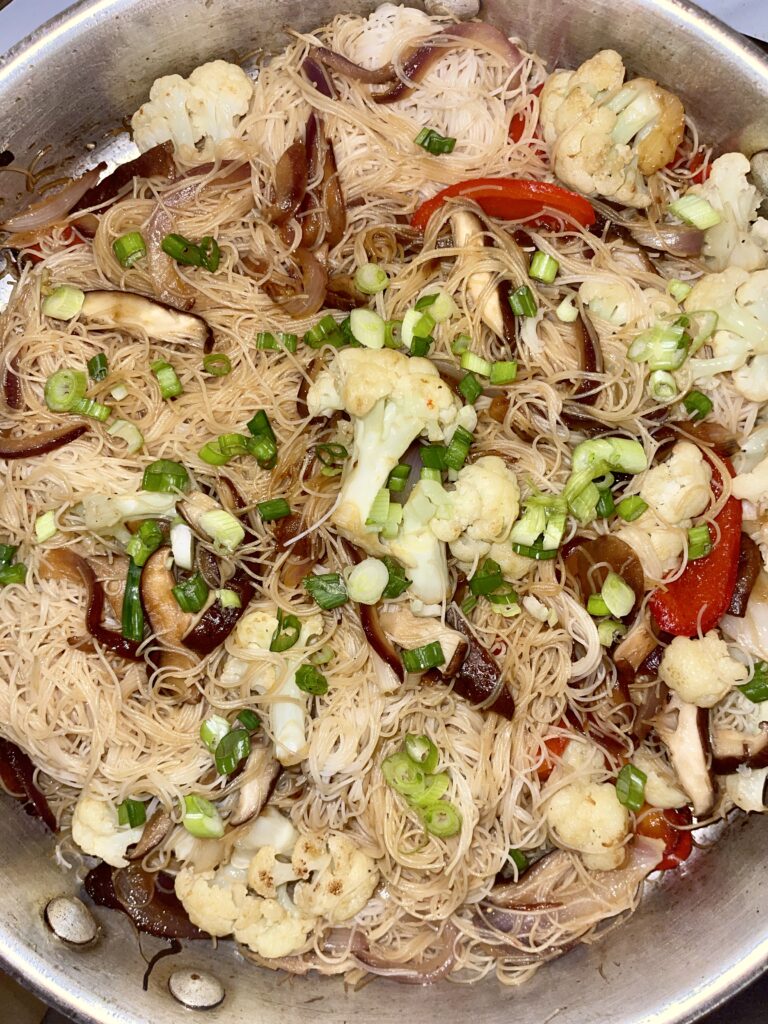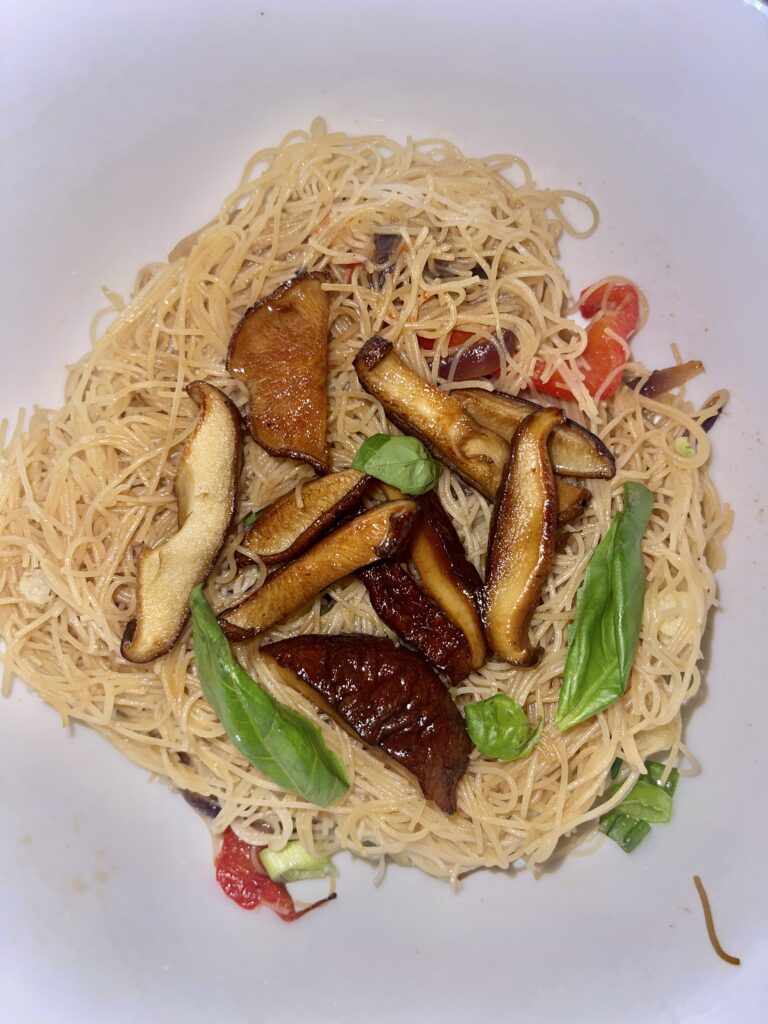This traditional Filipino dish is so simple yet satisfying. This is the easiest noodle dish you need to try making.

Vegan pansit bihon is a plant-based version of the traditional Filipino dish that typically consists of stir-fried thin rice noodles (bihon), vegetables, and sometimes tofu or tempeh. Instead of meat or seafood, vegan pansit bihon uses plant-based protein sources such as tofu, tempeh, or seitan. The vegetables used in vegan pansit bihon can vary, but commonly include carrots, cabbage, bell peppers, and green beans. The dish is often seasoned with soy sauce, oyster sauce (which can be substituted with vegan oyster sauce made from mushrooms), and other spices. Vegan pansit bihon is a popular dish among those following a plant-based diet or looking for a healthier alternative to the traditional meat-based version.

What is Pansit
Pansit is a Filipino dish that consists of noodles stir-fried with vegetables, meat, and/or seafood. The dish has its roots in Chinese cuisine, as many Filipino dishes do, and is believed to have been introduced to the Philippines by Chinese immigrants.
The word "pansit" comes from the Hokkien word "pian e sit," which means "something conveniently cooked fast." This reflects the dish's origins as a quick and easy meal that could be prepared with whatever ingredients were on hand.
Over time, pansit has become a beloved part of Filipino cuisine and is often served at special occasions such as birthdays, weddings, and fiestas. There are many different types of pansit, each with its own unique combination of ingredients and flavors.
Pansit bihon, which is made with thin rice noodles, is one of the most popular types of pansit in the Philippines. Other popular varieties include pansit canton (made with egg noodles), pansit malabon (made with thicker rice noodles and topped with seafood), and pansit palabok (made with rice noodles and topped with a shrimp sauce).
Today, pansit is enjoyed by Filipinos all over the world and has become a symbol of Filipino culture and cuisine.

Variations
There are many variations of vegan pansit that can be made by substituting plant-based ingredients for the traditional meat and seafood. Here are a few examples:
- Vegan Pansit Bihon - This dish is made with thin rice noodles, stir-fried with vegetables such as carrots, cabbage, and green beans, and seasoned with soy sauce, oyster sauce (which can be substituted with vegan oyster sauce made from mushrooms), and other spices. Tofu or tempeh can be added for protein.
- Vegan Pansit Canton - This dish is made with egg noodles, stir-fried with vegetables such as carrots, bell peppers, and onions, and seasoned with soy sauce, hoisin sauce, and other spices. Tofu or seitan can be added for protein.
- Vegan Pansit Malabon - This dish is made with thicker rice noodles, topped with a sauce made from vegetables and spices, and garnished with vegetables such as carrots, green onions, and cilantro. Tofu or tempeh can be added for protein.
- Vegan Pansit Palabok - This dish is made with rice noodles, topped with a sauce made from vegetables and spices, and garnished with vegetables such as green onions, cilantro, and sliced boiled eggs (which can be substituted with tofu or tempeh). The shrimp sauce can be substituted with a vegan version made from mushrooms.
These are just a few examples of the many variations of vegan pansit that can be made by substituting plant-based ingredients for the traditional meat and seafood.
What you need
- Rice noodles (vermicelli)
- mushrooms
- onions
- garlic
- scallions
- vegan oyster sauce or soy sauce
- veggies you have on hand, I used cauliflower & bellpepper
- sesame oil
- seasonings
What you do
- Soak vermicelli in hot water for 3 minutes, strain and run through cold water. Toss in sesame oil and season it up.
- Sauté aromatics, onions and garlic till translucent and fragrant, season as you go.
- Throw in cut up veggies. Stir fry a bit then add some liquid maybe veg stock or water, cover.
- When the veggies are fully cooked, toss in noodles and season with soy, aminos or vegan oyster sauce.







SUBSTITUTIONS
- Noodles: If you don't have bihon noodles, you can use rice noodles or even spaghetti noodles as a substitute.
- Protein: Instead of tofu, you can use tempeh, seitan, or even chickpeas as a protein substitute.
- Vegetables: If you don't have cabbage or carrots, you can use other vegetables like bell peppers, green beans, or snap peas.
- Sauce: Instead of soy sauce, you can use tamari sauce, coconut aminos, or even liquid aminos as a substitute.
FAQ
- Can I use a different type of noodle instead of bihon noodles?
Yes, you can use rice noodles or spaghetti noodles as a substitute for bihon noodles. - Can I use a different type of protein instead of tofu?
Absolutely! You can use tempeh, seitan, or even chickpeas as a protein substitute in your vegan pansit bihon. - Can I use a different type of vegetable instead of cabbage and carrots?
Of course! You can use vegetables like bell peppers, green beans, snap peas, or any other vegetables you prefer. - Can I use a different type of sauce instead of soy sauce?
Yes, you can use tamari sauce, coconut aminos, or liquid aminos as a substitute for soy sauce.
STORAGE
To store vegan pansit bihon, let it cool completely and then transfer it to an airtight container. It can be stored in the refrigerator for up to 3-4 days. Make sure to reheat it thoroughly before consuming.
Vegan Pansit Bihon
Ingredients
- 1 Bulb onion
- 5 Cloves garlic
- 1 Stalk scallions
- 1 Cup shiitake
- ½ Cup bell pepper
- ½ cauliflower
- 3 tablespoon sesame oil
- 5 tablespoon soy sauce / vegan oyster / liquid aminos
Instructions
- Soak noodles in hot water for 2 -3 minutes. Rinse and strain through running cold water. Toss in sesame oil.
- Sauté aromatics till fragrant and translucent. Add in all cut up veggies. Stir fry and season. Add veg stock, cover and let cook for 3-5 minutes.
- Toss in vermicelli, drizzle soy sauce and mix throughly. Make sure it is seasoned well. Garnish with slices scallions or what ever herb you might have on hand. Enjoy.






